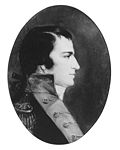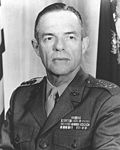| No. | Portrait | Commandant of the Marine Corps | Took office | Left office | Time in office | Notes |
|---|
| 1 | | Major
Samuel Nicholas
(1744–1790) | 28 November 1775 | 27 August 1783 | 7 years, 272 days | The first de facto Commandant for his role as the senior-most officer of the Continental Marines. [7] |
| 2 | | Lieutenant Colonel
William W. Burrows
(1758–1805) | 12 July 1798 | 6 March 1804 | 5 years, 238 days | The first de jure Commandant, he started many important organizations within the Marine Corps, including the United States Marine Band |
| 3 | | Lieutenant Colonel
Franklin Wharton
(1767–1818) | 7 March 1804 | 1 September 1818 | 14 years, 178 days | The first commandant to be court-martialed (acquitted) and the first to occupy the commandant's house at the Marine Barracks, Washington, D.C. |
| - | | Major
Archibald Henderson
(1783–1859)
Acting | 16 September 1818 | 2 March 1819 | 167 days | Acting Commandant, would later serve as Commandant from 1820 to 1859 |
| 4 | | Lieutenant Colonel
Anthony Gale
(1782–1843) | 3 March 1819 | 8 October 1820 | 1 year, 219 days | The second Commandant to be court-martialed and the only Commandant to be fired. Burial location is unknown and no authenticated images have ever been located. |
| 5 | | Brigadier General
Archibald Henderson
(1783–1859) | 17 October 1820 | 6 January 1859 | 38 years, 81 days | The longest-serving Commandant; known as the "Grand old man of the Marine Corps"; known for his role in expanding the Marine Corps' mission to include expeditionary warfare and rapid deployment [8] |
| 6 | | Colonel
John Harris
(1793–1864) | 7 January 1859 | 1 May 1864 | 5 years, 115 days | Commandant during most of the American Civil War |
| 7 | | Brigadier General
Jacob Zeilin
(1806–1880) | 10 June 1864 | 31 October 1876 | 12 years, 143 days | Became the Marine Corps' first general officer, officially approved of the design of the Eagle, Globe, and Anchor as the emblem of the Marine Corps |
| 8 | | Colonel
Charles G. McCawley
(1827–1891) | 1 November 1876 | 29 January 1891 | 14 years, 89 days | Chose " Semper Fidelis ", Latin for "Always Faithful", as the official Marine Corps motto |
| 9 | | Major General
Charles Heywood
(1839–1915) | 30 June 1891 | 2 October 1903 | 12 years, 94 days | Chose " Semper Fidelis ", Latin for "Always Faithful", as the official Marine Corps motto; he was the first Commandant to reach the rank of Major General |
| 10 | | Major General
George F. Elliott
(1846–1931) | 3 October 1903 | 30 November 1910 | 7 years, 58 days | Successfully resisted attempts to remove seagoing Marines from capital ships and to merge the Corps into the United States Army |
| 11 | | Major General
William P. Biddle
(1853–1923) | 3 February 1911 | 24 February 1914 | 3 years, 21 days | Established the Advanced Base Force, forerunner of today's Fleet Marine Force |
| 12 | | Major General
George Barnett
(1859–1930) | 25 February 1914 | 30 June 1920 | 6 years, 126 days | Served as Commandant during World War I, which caused a huge increase in personnel during his term |
| 13 | | Major General
John A. Lejeune
(1867–1942) | 1 July 1920 | 4 March 1929 | 8 years, 246 days | Started the tradition of the birthday ball with Marine Corps Order 47, still read annually. Commanded a US Army division (the 2nd Infantry Division) in combat during World War I. |
| 14 | | Major General
Wendell C. Neville
(1870–1930) | 5 March 1929 | 8 July 1930 | 1 year, 125 days | Recipient of the Medal of Honor and Marine Corps Brevet Medal |
| 15 | | Major General
Ben H. Fuller
(1870–1937) | 9 July 1930 | 28 February 1934 | 3 years, 234 days | Consolidated the Fleet Marine Force concept |
| 16 | | Major General
John H. Russell Jr.
(1872–1947) | 1 March 1934 | 30 November 1936 | 2 years, 274 days | The system of seniority promotions of officers was changed to advancement by selection, the 1st Marine Brigade was withdrawn from Haiti, and the number of ships carrying Marine detachments continued to increase. |
| 17 | | Lieutenant General
Thomas Holcomb
(1879–1965) | 1 December 1936 | 31 December 1943 | 7 years, 30 days | Expanded the Corps almost 20 times in size for World War II and integrated women into the Corps. The first Marine to be advanced (after retirement) to the rank of General |
| 18 | | General
Alexander Vandegrift
(1887–1973) | 1 January 1944 | 31 December 1947 | 3 years, 364 days | Recipient of the Medal of Honor. Was the first active duty Marine to hold the rank of General, resisted attempts to merge the Corps with the Army |
| 19 | | General
Clifton B. Cates
(1893–1970) | 1 January 1948 | 31 December 1951 | 3 years, 364 days | Recipient of the Navy Cross. Commandant during early stage of the Korean War. |
| 20 | | General
Lemuel C. Shepherd Jr.
(1896–1990) | 1 January 1952 | 31 December 1955 | 3 years, 364 days | Recipient of the Navy Cross and last World War I veteran to be Commandant. First Commandant to serve on the Joint Chiefs of Staff. Commandant during the Korean War. |
| 21 | | General
Randolph M. Pate
(1898–1961) | 1 January 1956 | 31 December 1959 | 3 years, 364 days | Commandant between U.S. involvement in the Korean War and Vietnam War. |
| 22 | | General
David M. Shoup
(1904–1983) | 1 January 1960 | 31 December 1963 | 3 years, 364 days | Recipient of the Medal of Honor. Opposed U.S. involvement in South Vietnam based on strategy and undue influence of corporations and military officials in foreign policy. Historians consider Shoup's criticisms to be among the most pointed and high-profile leveled by a veteran against the Vietnam War. |
| 23 | | General
Wallace M. Greene Jr.
(1907–2003) | 1 January 1964 | 31 December 1967 | 3 years, 364 days | Oversaw the expansion of the Corps role in the Vietnam War |
| 24 | | General
Leonard F. Chapman Jr.
(1913–2000) | 1 January 1968 | 31 December 1971 | 3 years, 364 days | Was the commandant during the final years of U.S. involvement in the Vietnam War. During his period in command, the III Marine Amphibious Force withdrew from Vietnam and the strength of the Corps dropped from a peak of 289,000 to 198,000. |
| 25 | | General
Robert E. Cushman Jr.
(1914–1985) | 1 January 1972 | 30 June 1975 | 3 years, 180 days | Oversaw the withdrawal of the Marines from Vietnam and a decline in the Corps' peacetime strength to 194,000 |
| 26 | | General
Louis H. Wilson Jr.
(1920–2005) | 1 July 1975 | 30 June 1979 | 3 years, 364 days | Recipient of the Medal of Honor for capture of Guam |
| 27 | | General
Robert H. Barrow
(1922–2008) | 1 July 1979 | 30 June 1983 | 3 years, 364 days | Last World War II veteran to be Commandant. Was the first Commandant to serve as a full member of the Joint Chiefs of Staff, acquired approval of production of the American-modified Harrier aircraft, and several other improvements to enhance the effectiveness of the Marine Corps |
| 28 | | General
Paul X. Kelley
(1928–2019) | 1 July 1983 | 30 June 1987 | 3 years, 364 days | Commandant when the Marine Barracks bombing occurred in Beirut during the 1982–84 multinational force peacekeeping mission under the Reagan Administration. |
| 29 | | General
Alfred M. Gray Jr.
(1928–2024) | 1 July 1987 | 30 June 1991 | 3 years, 364 days | The Alfred M. Gray Research Center at Marine Corps Base Quantico houses the Marine Corps Archives and Special Collections, the Quantico Base Library, and the research library for the Marine Corps University.
As a reminder that the primary role of every Marine is a rifleman, he had his official photograph taken in the Camouflage Utility Uniform, the only Commandant to have done so. Last Korean War veteran to serve as Commandant. |
| 30 | | General
Carl E. Mundy Jr.
(1935–2014) | 1 July 1991 | 30 June 1995 | 3 years, 364 days | After retirement, he served as president and CEO of the United Service Organizations (USO), and was the chairman of the Marine Corps University Foundation. |
| 31 | | General
Charles C. Krulak
(born 1942) | 1 July 1995 | 30 June 1999 | 3 years, 364 days | Son of Marine Corps Lieutenant General Victor H. Krulak. Came up with the concept of the 'Strategic Corporal' and the 'Three Block War'. Introduced The Crucible, a final test of Marine recruits. |
| 32 | | General
James L. Jones
(born 1943) | 1 July 1999 | 12 January 2003 | 3 years, 195 days | Oversaw the Marine Corps' development of MARPAT camouflage uniforms and the adoption of the Marine Corps Martial Arts Program; later became the first Marine officer to serve as Commander, U.S. European Command (USEUCOM) and NATO's Supreme Allied Commander Europe (SACEUR), then as National Security Advisor for the Obama Administration. |
| 33 | | General
Michael W. Hagee
(born 1944) | 13 January 2003 | 13 November 2006 | 3 years, 304 days | Guided the Corps through the initial years of the Iraq War
Last Vietnam veteran to serve as Commandant |
| 34 | | General
James T. Conway
(born 1947) | 13 November 2006 | 22 October 2010 | 3 years, 343 days | Commanded Marine forces in the Iraq War and oversaw expansion of the Corps to 202,000 personnel.
First Commandant in nearly 40 years to have not served in the Vietnam War. |
| 35 | | General
James F. Amos
(born 1946) | 22 October 2010 | 17 October 2014 | 3 years, 360 days | Oversaw the repeal of the "don't ask, don't tell" policy in the Marine Corps.
First naval aviator to serve as Commandant. [9] |
| 36 | | General
Joseph Dunford
(born 1955) | 17 October 2014 | 24 September 2015 | 342 days | First Commandant and second Marine to be appointed to Chairman of the Joint Chiefs of Staff. |
| 37 | | General
Robert Neller
(born 1953) | 24 September 2015 | 11 July 2019 | 3 years, 290 days | Led the integration of women into combat roles. Made administrative regulations for Marines on social media. |
| 38 | | General
David H. Berger
(born 1959) | 11 July 2019 | 10 July 2023 | 3 years, 364 days | Issued guidance for Service-level planning to include refocusing on high-end combat, shifting away from tanks and artillery in favor of long-range missiles and drones. |
| - |  | General
Eric M. Smith
(born c. 1964) | 10 July 2023 | 22 September 2023 | 74 days | Served as acting commandant after Berger's retirement amid Senator Tommy Tuberville's hold on military nominations, and sworn in following confirmation. [10] [11] |
| 39 | 22 September 2023 | Incumbent | 2 years, 11 days |












































